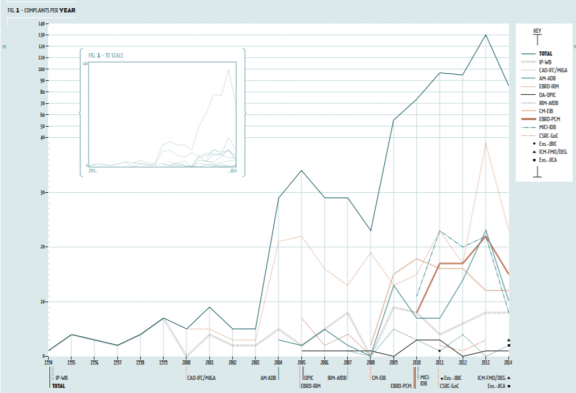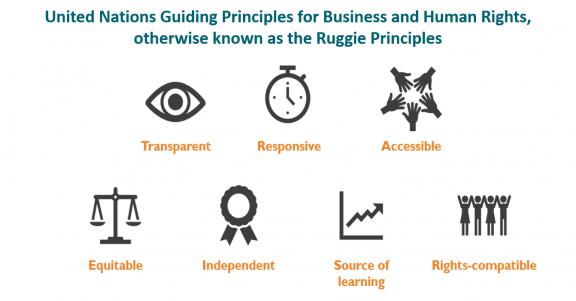At the crossroads: Independent accountability mechanisms’ reforms
In 2011, in a coastal community in Gujarat, India, local fisherfolk became concerned about the potential impacts that a planned 5000-megawatt coal-fired power plant would have on their livelihoods. The community complained about these concerns, among others, to the accountability mechanism of one of the funders, the Compliance Advisor Ombudsman (CAO) of the International Finance Corporation (IFC).
Following an investigation, the CAO found that the IFC had violated its own policies for assessing potential social and environmental impacts. The IFC responded with a remedial action plan, but the CAO found the steps included to be inadequate to fully address the concerns raised. In 2016, the community then decided to take their case further and sued the IFC in a US District Court. This case, known as Jam v. IFC, made waves in international development as it overturned a previously held view that the IFC had absolute immunity from being sued in US courts. The surrounding media coverage has placed substantial scrutiny on the accountability of International Finance Institutions (IFIs).
It is within this context that Independent Accountability Mechanisms (IAMs) across the world have undergone a period of reform. While some of these reforms have been progressive, others have been regressive.
These reforms are occurring more than 25 years after the first IAM, the Inspection Panel (IPN) of the World Bank (WB) was created. Since then, IAMs have significantly increased in number and the number of complaints made to them has also risen sharply (Figure 1). While on the one hand this rise in complaints may be viewed as a positive trend, illustrating an increase in accessibility for those adversely affected by projects and programmes of IFIs, it is also indicative of the scale of ongoing harm to communities caused by IFI-funded projects.

Source: SOMO (2016). “Glass Half Full? The State of Accountability in Development Finance”. p.20-21.
The Ruggie Principles
IAMs exist to hold IFIs accountable for the negative impacts of the projects they finance and provide affected communities with an avenue for redress. While there are some substantive differences between IAMs due to the varying mandates of their parent organisations, there is also a clear standard against which all IAMs should be assessed. In 2011, the United Nations endorsed the Guiding Principles for Business and Human Rights, otherwise known as the Ruggie Principles. Here, the principle of ‘access to remedy’ was enshrined, and criteria provided for the effectiveness of non-judicial grievance mechanisms such as IAMs.
The eight Ruggie principles have since come to gain widespread acceptance by the international community and business leaders. IAMs must be legitimate, they must enable trust from all stakeholder groups and be accountable for the fair conduct of grievance processes. They must be accessible. This means that they need to be known to all stakeholders and that assistance should be provided for those who may face barriers to accessing the mechanism. IAMs also need to be predictable; they should provide a clear and known procedure, within predetermined time frames, with clarity on the types of processes, outcomes available and means of monitoring implementation. An important criterion is that IAMs need to act equitably, seeking to ensure that all parties have access to the information, advice and expertise necessary to engage in a grievance process on fair, informed and respectful terms. The sixth principle is transparency. It is essential that all parties are made aware of the progress of the grievance process, and more generally, transparency is essential to evaluate the mechanism’s performance. Next, the process needs to be rights-compatible. In other words, the IAM needs to ensure that outcomes and remedies accord with internationally recognised human rights. These processes should also be a source of continuous learning, so that lessons can be identified to improve the parent institutions decision-making processes, policies and projects so that future grievances and harms may be prevented or mitigated. And lastly, IAMs and their processes should be based on engagement and dialogue. This requires consulting various stakeholder groups for the design of the mechanisms, and during the process of address and resolution of grievances.

Source: Adapted from United Nations (2011). “Guiding Principles on Business and Human Rights”.
Four Recent IAM Reforms
Given the current context, it is important to understand the extent to which this wave of reforms is strengthening and furthering these principles. This will be done by examining the content of four recently conducted reviews, and evaluating them in the context of the relevant principles listed. The IPN/WB underwent reform between 2017 and 2018 (with some reforms announced in March 2020), following the adoption of a new Social and Environmental Framework. These reforms were described as a review of its “toolkit” referring to the various interventions the IPN/WB was empowered to make in respect of complaints. Despite this terminology, the end product was a set of reforms. In 2017 and 2019 respectively, the Independent Redress Mechanism (IRM) of the Green Climate Fund (GCF) announced its new Updated Terms of Reference and its new Procedures and Guidelines which replaced the interim procedures which had been in place up to that point. More recently in 2019, the European Bank for Reconstruction and Development (EBRD) completed a comprehensive review of its complaints mechanism, which resulted in the new accountability policy and structure of the Independent Project Accountability Mechanism (IPAM). This came into effect at the beginning of 2020. The Asian Infrastructure Investment Bank (AIIB) presents a slightly different case as it is a new institution. Therefore, rather than a review or reform, the policies referred to represent the first of the Project-affected People’s Mechanism (PAPM) which was approved by AIIB’s Board in December 2018.
1. Legitimacy
Legitimacy incorporates a number of different elements, all of which are key to ensuring that the IAM is trusted by those for whom the mechanism is intended. Trust is essential as without it, the efficacy of IAMs becomes irrelevant as it will not be used by the communities it intends to serve.
One element of legitimacy is independence; from management, funders, political actors and other units within the parent organisation. While all the IAMs reviewed have direct-line reporting to their respective Boards, in line with international best practice, other questions regarding their independence have been raised.
After an almost 2-year delay, the IPN/WB announced the final outcome of its review process in March 2020. One of the announcements was the change to the structure of the accountability mechanism. A new dispute resolution service has been created (an introduction welcomed by many) and this will be hosted together with the IPN/WB under a new Accountability Mechanism, headed by a new executive secretary appointed by and reporting to the Board. This has raised concerns by some civil society observers about the potential impacts on the IPN/WB, as the role of this new body has yet to be clarified in detail, potentially providing scope for undue interference into the functioning of the IPN/WB and confusion as to the roles and powers of each body within the Accountability Mechanism. These observers note that in the worst case, this could result in barriers to the fair and effective functioning of the IPN/WB. In the case of the AIIB, the PAPM/AIIB is housed in one large unit tasked with multiple functions, the Complaints-resolution, Evaluation and Integrity Unit (CEIU). Due to the vastly different mandates falling under this description, some observers argue that there is a potential for conflicts of interest to arise, for example between the complaints and evaluation functions. They believe that it has the potential to undermine the independence of the PAPM/AIIB, even if the unit itself has a direct reporting line to the Board.
2. Accessibility
One of the most important principles is that of accessibility; ensuring that individuals and communities who need to use the mechanisms are able to.
Development projects almost always take place in poor communities, often in areas with low levels of literacy or access to information. Therefore, communities simply being unaware of the existence of a grievance mechanism is a significant barrier to improved effectiveness. One of the ways in which IAMs can reduce this barrier is by doing activities to let communities in project areas know of their availability and function and by informing civil society organisations as to how they can help individuals and communities reach IAMs. The four recently reviewed IAMs each make provision for outreach activity. However, more can be done to ensure that the information is obtained by those who need it most, especially in situations where there are multiple funders of the project or when project financing is conducted through intermediaries. One recommendation by CSOs is that implementing clients or entities should be mandated to disseminate information about the IAM to local communities. The only IAM which has yet to adopt this is the IPAM/EBRD and it will undoubtably be a useful tool to bridge the, often large, gap between the IFI, the IAM and the project-affected communities.
The next stage, once an individual or community knows about the IAM, is filing an eligible complaint. The accessibility of different mechanisms varies tremendously in this regard. In a letter from more than a dozen international CSOs, the PAPM/AIIB was criticised for its limited accessibility. The letter stated that the PAPM/AIB policy on time eligibility was too restrictive, allowing for the submission of complaints only after the project has been approved (thereby not allowing for the prevention of harm) and up until the official closing date of the project or the last disbursement of funds. Only in exceptional circumstances, can complaints be made in the two years following closure. The letter also detailed several other barriers to accessibility. They include complex procedures for filing a complaint, the prohibition of non-local assistance, except in exceptional cases, and the high number of exclusion criteria. This includes if a project was co-financed under the terms of other funders’ social and environmental standards, high evidence requirements for illustrating harm and requiring proof that complainants have attempted to solve the problem through both the project-level grievance mechanism and by working with management ‘in good faith’. The IPN/WB recently announced the extension to its time eligibility requirement from the closing date of the project, or after 95% of the funds have been disbursed, to up to 15 months after the closing date of the project. The IPAM/EBRD has also expanded its temporal eligibility, to up to 2 years after the EBRD no longer has any financial interest in the project.
The IRM/GCF, on the other hand, goes further than any other IAM in making the mechanism as accessible as possible. Unlike the other mechanisms which require complaints to be submitted in writing (and usually in an official language), the IRM/GCF allows for complainants to make submissions by any means available to them, not only in a written form, and in any language. Additionally, submissions can be filed either within two years from the date the complainant became aware of the adverse impacts or two years after the closing date of the project, whichever date is later.

3. Predictability
In order for IAMs to be viewed as effective, trustworthy and relevant to stakeholders, the procedures and processes of complaints should be clearly outlined, communities need to have faith that their findings are taken seriously by management and clients and that appropriate actions are taken to address or compensate the harm caused. While in all cases, remedial actions are designed by the management of the IFIs in response to IAM findings (and in some IAMs, recommendations), one of the key ways in which IAMs differ is their monitoring and oversight functions on the design and implementation of these plans.
According to some commentators, the inclusion of a monitoring function for the IPN/WB was a particularly controversial part of its review, due to alleged perceptions of undue ‘meddling’ in the management of the World Bank, and therefore it was one of the decisions that was only recently announced. The new reforms make provision for some oversight and monitoring capacity, where previously there was none. This provision allows for the IPN/WB to ‘verify’ the Bank’s Management Action Plans (MAPs). However, in order to do so, the IPN/WB requires approval from the Board and verification can only occur after there has been “substantial implementation” of the MAP and/or if management monitoring reports a failure of implementation. Additionally, the verification is limited, with the policy stating that site visits should be limited to one and there is no scope for the IPN/WB to make comments on the content of the MAP itself.
In comparison, most other IAMs have long held monitoring functions that are more robust than the reforms adopted by the WB’s Board in this aspect of the IPN/WB’s reforms. The IPAM/EBRD, the PAPM/AIIB and the IRM/GCF all have monitoring functions, although some are more extensive than others. The IRM/GCF is required to approve the remedial action plans of management, and can request an upgrade if found to be inadequate and both the IPAM/EBRD and IRM/GCF can report any issues regarding implementation or non-compliance of remedial actions to the Board.
4. Transparency and Stakeholder Engagement
The next two criteria are closely linked as one can only engage meaningfully with stakeholders if decisions, processes and policies are known and available to them. Transparency of IAMs is one of the biggest concerns of CSOs in the accountability sector and has been a source of much criticism. One civil society organisation has criticised the PAPM/AIIB’s policies for only committing to making summaries of their investigations and assessments publicly available, preventing an external analysis of the validity of those findings. The IPN/WB’s reform process on the other hand, has been criticised by commentators for its lack of transparency during the review period itself. This has been accompanied by a lack of opportunity and information for adequate and legitimate stakeholder engagement, undermining the public acceptance of the review process and preventing useful input by affected communities and CSOs from being incorporated. Transparency is necessary for a truly accountable, effective and modern mechanism. In contrast, the IPAM/EBRD and IRM/GCF both had extensive consultation periods (17 and 24 months respectively), which resulted in significant inclusions into the final policies. The IPAM/EBRD and IRM/GCF have also introduced measures to increase transparency and stakeholder engagement by disclosing all case reports and by offering complainants the opportunity to comment on draft IAM reports and MAPs and monitoring reports.
5. Source of continuous learning
Processing complaints is arguably the most important function of IAMs of IFIs today. However, in order for the mandate of helping communities to move beyond an individual complaints process, IAMs need to also act as sources of knowledge and experience for the improvement of policies of the parent institution. It is only in this way that lessons learned can be used to prevent future grievances and harms. This is conducted largely through an advisory function, which, to varying degrees, all the reviewed IAMs now have. Within this mandate, the IAM provides advice to the management of the IFI on how to improve its policies and guidelines based on its experiences and, in some cases such as in the IRM/GCF, also based on international best practices.
The IPAM/EBRD also provides an additional source of learning for the EBRD and another level of accountability for its clients and implementing partners. The new policy states that if a proposed client has previously been party to, or the subject of, a complaint at the IPAM/EBRD, that information will be sent to the Board and taken into consideration before the EBRD makes any additional investments. This provides a strong financial incentive for clients to abide by social and environmental safeguards and ensures that clients known to cause harm to communities no longer receive funding.

Conclusion
This brief analysis of the most recently condhttps://www.somo.nl/reviews-of-world-bank-groups-accountability-mechanisms-too-important-to-be-done-in-secret/ucted reviews of four IAMs illustrates that reforms and reviews are not uniformly evolving in a direction in conformity with the Ruggie Principles. Rather, we can observe a mix of changes. While some of these are likely to increase the effectiveness of the IAMs, through strengthening their foundational principles, others are likely to undo some of these efforts.
These are important lessons to be learned for other IAMs and IFIs and how they conduct their reforms. Currently, two additional IAMs are under a period of review. The Independent Review Mechanism (IRM) of the African Development Bank (AfDB) recently started its Third Review, which is set to be concluded in January 2021. The Compliance Advisory Ombudsman (CAO) of the International Finance Corporation (IFC) and the Multilateral Investment Guarantee Agency (MIGA) has also initiated a review “in the context of the IFC’s strategy to engage in more challenging markets and litigation questioning the extent of our accountability”. This is planned to be concluded in May of this year (2020). Although not yet complete, this process has already drawn criticism from CSOs for its lack of transparency, similar to those lodged against the IPN/WB’s review process. This includes the failure to publish the review team’s terms of reference, no commitment to disclose the final recommendations and no space for public comments on the recommendations. To what extent this is likely to undermine the trust of affected stakeholders in both the process and its outcomes is yet to be seen.
The mandate, power and effectiveness of IAMs are being subject to review both internally, within IFIs, and externally. This can be observed in the backlash they have faced following the Jam v. IFC case, which illustrated an example where an IAM’s recommendations were not heeded and implemented. Unfortunately, this is not a once-off occurrence and the need for communities to use judicial mechanisms to achieve redress is a step in the wrong direction, as these are generally less accessible to most communities affected by IFI-funded projects. For IAMs to maintain their relevance as a foremost avenue for redress, they need to ensure that they increase their efficacy by strengthening the fundamental principles on which they are based, in accordance with the internationally accepted Ruggie Principles. Without this, there is a risk that accountability and redress will become less accessible to communities and IFIs will also open themselves up to potentially expensive and reputation-damaging lawsuits. In this sense, IAMs are at a crossroad and it behooves their parent institutions to act with vision and care.
Article prepared by Katrina Lehmann-Grube and Lalanath de Silva